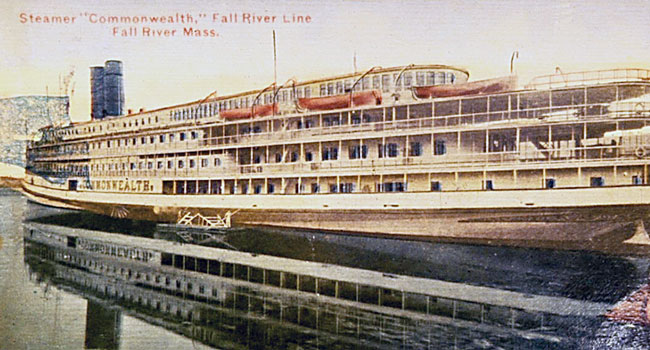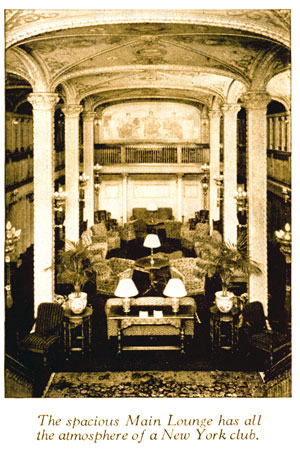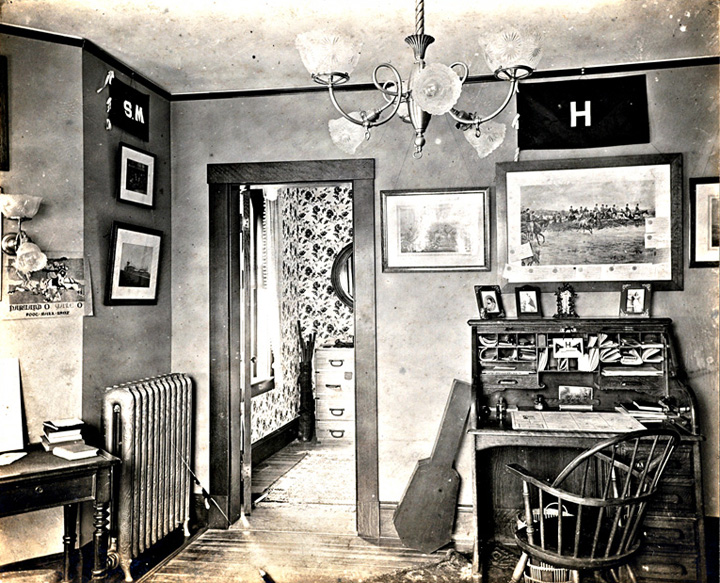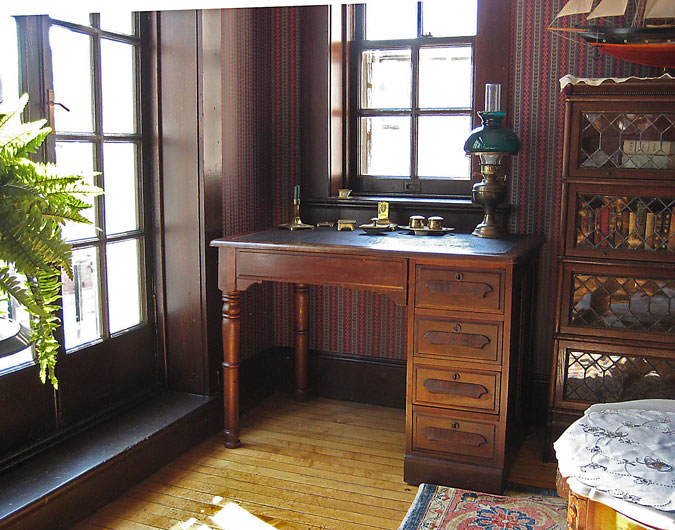I have another circular tale for your consideration:
During our recent open house over the Harvard-Yale weekend, many of you wanted to know how we found period items for the Suite.
Well, basically it works like this: Three years ago, during our early research, we created a list of objects – furniture, textiles, art, memorabilia, etc. – that were documented from FDR’s letters & other historical records as having been in the Suite, or were presumed from similar rooms pictured in the Harvard Archives. After that, the process essentially became one large treasure hunt, played across three continents. Whenever my day job permits a bit of down time, I don my Restoration cap, and go out hunting. Sometimes the trips are physical – days spent at antique fairs, or journeys to out-of-the-way dealers – but more often than not, I close the door to my office, and disappear into the Internet. I’ve become a modern day FDR sleuth in my spare time, tracking down bits of early 20th century Harvard from all over the globe. This is especially true when it comes to all the ephemera that once filled the FDR Suite, and which one day, Deo volente, will again. Unfortunately, acquiring this material is not at all straightforward. What was a matter of simple retention for Lathrop and Franklin – a saved theater program here, a football ticket there – becomes hugely involved a hundred years later. Most of the time, when these kinds of items appear, they are offered singly, from single sources, and at great cost.
But not always…
An example: I was delighted to receive a notification last week that a collection of Harvard memorabilia from the estate of Walter S. Hertzog ’05 was going to be sold on Ebay. (For those of you wondering how I learned this, you can program the EBay site to notify you when objects within a certain parameter appear for auction.) While the years weren’t quite what we normally look for, (FDR and Lathrop were ’04), the match was close enough to interest me if the price were right.
Here’s what the collection looked like when I first saw it online. (This is but one view of the original eight.)

“Good lord!” you may be thinking to yourself. “What IS all that stuff? Looks like old scrap paper!” Well, to some extent it is, and before I started researching the FDR project, I might have expressed the same, but now, having seen an odd dozen of these Victorian student collections in the Harvard Archives, certain elements jump right out. For example, that little piece with the string? It’s is a dance card, worn about the wrist; one lovely lady per dance, still signed up a century later. The postcards with stamps? Those are grade or class notifications: the penny post was the email of the day, and a letter mailed from the College in the morning had a very good chance of arriving that afternoon, in one of the three daily-mail services. You see these cards all over the period photos, if you look closely, tucked into pictures here, there and everywhere. For example, this is the desk I showed you in the last posting:

Now if you look very, very carefully, in the hunting scene above the desk, you’ll see the postcards tucked into the frame. This appears again and again in the period room views we possess, and now, at last, we’ll have some of these exact cards for the Suite:

Then too, on closer inspection, in the cubbyholes of the desk you can make out class exams, grade sheets, tuition bills, all the flotsom and jetsom of student life in 1900 Harvard. This is exactly mirrored in the EBay collection. While some of this material, especially the programs for the 1905 Class Exercises won’t be of use to us, much will, added to the Suite to fill out the picture of everyday living in 1904. But among all this, here are two items I found particularly interesting:

Now the Fall River Line may not ring any bells to you, having disappeared in 1937, but if you were a wealthy New Yorker in Boston at the turn of the century, you would most certainly recognize the name, as the Line, which ran a train service from Boston to Fall River, and then a steamship service to New York, was one of the easiest and most luxurious ways to travel to and from New England in 1900.

You see, before the days of direct express service, you generally needed to transfer trains multiple times from Boston to New York, and depending on what Road you used, you might even need to disembark in New Jersey and take a ferry into Manhattan at the end of your journey. (No tunnels at that time!) So instead of this tiresome rail trek, many people in-the-know took the luxurious steamers of the Fall River Line, like the Commonwealth, to New York.  Now this was no run-of-the-mill boat: first class passengers had their own cabins for the eight hour voyage, and the public spaces, as you can see from the picture to the left, were highly luxurious, featuring a library, smoking room, and a dining room that served a full dinner service, hence the menus we found on EBay.
Now this was no run-of-the-mill boat: first class passengers had their own cabins for the eight hour voyage, and the public spaces, as you can see from the picture to the left, were highly luxurious, featuring a library, smoking room, and a dining room that served a full dinner service, hence the menus we found on EBay.
So what you may ask, has this to do with our hero, FDR?
Here’s a bit from his letter to Sara dated October 8, 1902
Today Alice Sohier left for Europe, and I saw her off on the “Commonwealth.”
Alice Sohier, for those of you wondering, was a strikingly beautiful Boston debutante who had infatuated FDR. As the story goes, he proposed, she declined, and went off to Europe, departing, as the first stage of her trip, on the Commonwealth to New York. So, do you suppose the couple had one last meal together from this exact menu before the steamer departed, and did FDR once more plead his case? And, had Alice accepted, would young Frank ever become the FDR we now know? We’ll never be sure.
A year later, Franklin proposed to Eleanor, and the rest, as they say, is history.
For our purposes, however, the EBay find presents a wonderful chance to expand and amply the Suite’s narrative, so we’re going to add these menus to the period wire hanger above FDR’s desk, along with an elaborately framed photo of Alice destined for the desk top, as an almost forgotten memento of a farewell lunch that might – given a different response – have changed American history.
All well and good you say. All well and good. But did you finally acquire the items, and at what cost? It must be stupendous!
Nope. A total of $137.50, all brought about by supporters like you.
Oh, and a final postscript: In an ever so appropriate twist, Dr. Walter S. Hertzog ’05 would later become, of all things, the Director of American Historical Research for the Los Angeles City School Department. The items he so carefully preserved will finally return to Harvard next week, after a century of almost unimaginable journeys. Those pieces not used in the Suite will be donated to the Harvard Archives.
You see, as I promised: a circular tale, indeed.
The FDR Suite Restoration Project at Adams House, Harvard College is funded entirely through your contributions to the FDR Suite Foundation Inc, a public 501(c)3 charity set up to create a living memorial to FDR at Harvard, as well as a museum of 19th century Harvard student life. We do not receive funds from the University to support this endeavor, and rely on your help to continue our efforts!

 l
l m
m -g
-g n
n d
d





